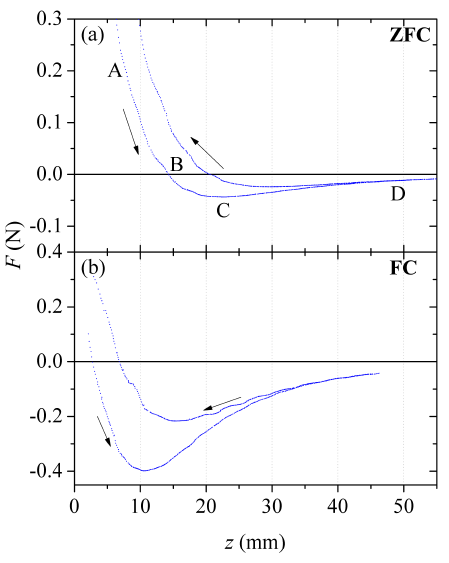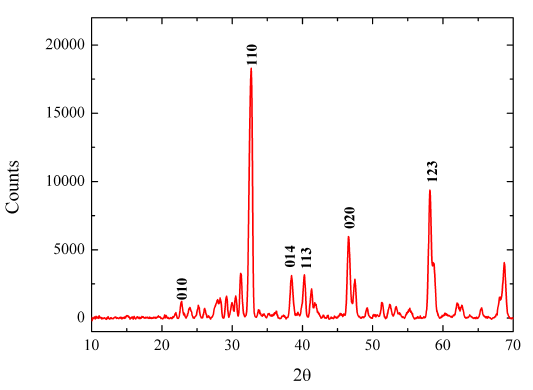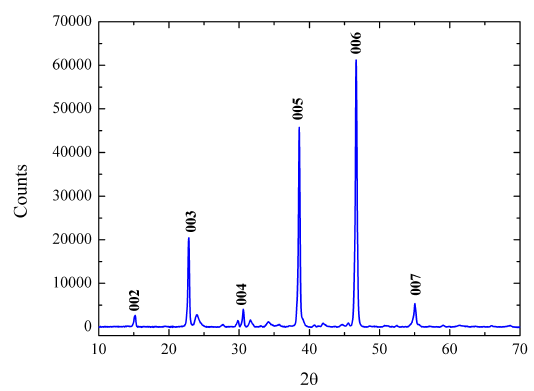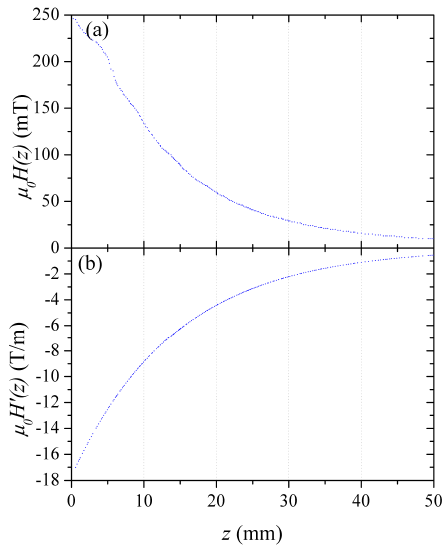1. Introduction
The interaction between high Tc superconductors (HTS) and a permanent magnet (PM) shows the levitation (repulsion) and suspension (attraction) phenomena, which have been a subject of great interest in the last three decades, due to the potential applications such as energy storage systems [1-3], levitating vehicles [4-8] and high-speed bearings [9, 10]. The interaction forces between a superconductor and a permanent magnet (HTS-PM system) can be measured in the three-dimensions [11-13]; however, the levitation and suspension phenomena in an HTS-PM system are possible when the force has the opposite direction of gravity, which compensates the weight of the HTS or the PM. Thus, the most common measurement of this type of interaction is the one carried out vertically.
One of the main characteristics of the interaction forces in an HTS-PM system is the hysteresis loops present when the superconductor and the magnet are moving relative to each other in any of the two regimes ZFC or FC. In all the cases, the force is hysteretic because of the hysteresis in magnetization [5, 14-16]. The hysteresis behaviour also depends on several factors like the fabrication method [17, 18], volume and geometry of both, superconductor and magnet, the relative velocity between magnet and superconductor, type of magnet [19] and the configuration of the HTS-PM system [20, 21]. Several approximations have been proposed to explain this type of interactions, like frozen-image method [22-24], also different analytical and numerical solutions have been studied using the critical state model for some particular configurations [25-30].
The measurements of the interaction force HTS-PM were carried out with a relatively simple technique developed here, which is reproducible, reliable and low cost based on the system developed by S. O.Valenzuela et al [31]. This technique allows doing qualitative predictions about quality of the superconducting material for different applications. The obtained results were analyzed using the Bean´s critical-state model in the approximation of a uniform field applied to the superconductor [32-34]. In spite of our main goal was the qualitative determination of some properties of superconductors, the critical current values determined using this technique showed remarkable differences between both samples analyzed, as those obtained by other methods for example by magnetization measurements using a vibrating sample magnetometer.
2. Theoretical Framework
We studied the attraction and repulsion forces produced by the interaction between a HTS and a PM when they are moving a distance z relative to each other. In this case, we consider that supercurrents fill a volume V where the magnetic field is uniform enough in order to define a mean magnetization M. A simplified relation between the force along z-axis (F z ) and the vertical component of applied magnetic field (H z ) can be found and is given by Equation (1) [31, 35].
Where M
z
is the constant magnetization in the z-axis direction,  represents the field gradient along the z direction, and V the volume of the sample. The values of the magnetic field and its derivative are assumed constant over the HTS and the demagnetization effects due to finite dimensions have been neglected [32-34]. For a permanent magnet (PM), its magnetic field H(z) decreases when the distance z HTS-PM increase, therefore
represents the field gradient along the z direction, and V the volume of the sample. The values of the magnetic field and its derivative are assumed constant over the HTS and the demagnetization effects due to finite dimensions have been neglected [32-34]. For a permanent magnet (PM), its magnetic field H(z) decreases when the distance z HTS-PM increase, therefore  is always negative. Since V and µ0 are positive, then, according to Equation (1), the sign of F
z
is opposite to the sign of M
z
.
is always negative. Since V and µ0 are positive, then, according to Equation (1), the sign of F
z
is opposite to the sign of M
z
.
The relations between the magnitude of the current density and the magnetization for a rectangular-like and disk-like geometry are given by Equations (2) and (3) respectively
and
Where d is the thickness of the rectangular sample and R is the radius of the disk-shaped sample.
3. Experimentation
Figure 1 shows the experimental setup used to measure the interaction forces in the HTS-PM system [29]. A digital balance (Citizen CY 204) was used, with a resolution of 10-4 g and a maximum capacity of 220 g. A permanent magnet of Nd-Fe-B with dimensions 40 X 25 X 5 mm, was fixed 7 cm above the center of the balance's plate. The system also includes an endless screw, which allows high accuracy in the distance measurements. The superconducting samples used, were permanently immersed in liquid nitrogen and attached to the polycarbonate arm. In our case, the applied field at the sample increase when the HTS is descending (descending direction) and decrease when the HTS is moving in the opposite direction (ascending direction).
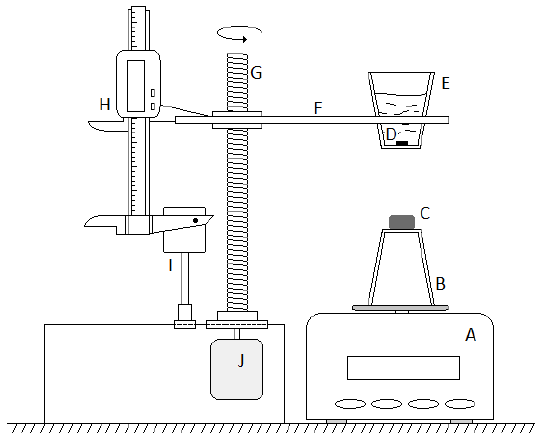
Figure 1 Experimental setup: (A) Electronic balance with digital display, (B) pan of the balance, (C) neodymium permanent magnet, (D) superconducting sample, (E) vessel with liquid nitrogen, (F) polycarbonate arm, (G) endless screw, (H) digital Vernier caliper, (I) support for the digital caliper, (J) DC electric gear motor
In order to move them vertically at a constant velocity (in this case at 0.2 mm/s), we use a DC electric gear motor. A digital Vernier, with a resolution of 0.01 mm, was used to measure the relative distance HTS-PM. The balance properly calibrated displays positive and negative values when the force is repulsive and attractive respectively. The ascent and descent measurements were carried out in a continuous manner in the FC and ZFC regimes for each sample. All of the measurements were performed cyclically from a distance of 1 mm between HTS and PM, up to a maximum distance of approximately 45 mm.
The superconducting disk-shaped sample (YBCO-123) with diameter 10 mm and thickness 4 mm was produced by the solid-state reaction method, fromY2O3, CuO and BaO high purity oxides in stoichiometric quantities and mixed in a Zirconium balls mill. The mix was annealed at 860 °C and oxygenated in O2 flux at 500 ℃ during different times [36]. A second rectangular sample with dimensions 14 X 10 X 2 mm was produced by the Melt-Textured Growth (MTG) process [37]. The above mentioned neodymium permanent magnet was used in both cases.
4. Results and discussion
Figures 2 and 3 show the behaviour of the force as a function of the distance HTS-PM for the texturized (MTG) and sintered samples, respectively. The hysteresis curves show that the behaviour of the force as a function of the distance and its maximum value depends on the increasing or decreasing of the relative distance HTS-PM and on the cooling process ZFC or FC regimes (It is worth to note that in the ZFC regime the cooling of the sample was done removing completely the permanent magnet of the setup). Table 1 presents the maximum values of the force determined for both samples experimentally in the FC regime, and other values obtained using the Equation (1). As observed, the force is greater by two orders of magnitude in the texturized sample (MTG) than in the sintered one.
The observed hysteretic behaviours are related to hysteresis in the magnetization (M) of the sample. For type II superconductors, a magnetic flux B can penetrate from its surface when a magnetic field H is applied. This produces a magnetization M = B/µ0 - H in the material. On the other side, since the applied field decreases with the distance to the permanent magnet, its gradient is negative [Figures 6a and b); then according to Equation (1), the force has an opposite sign than the magnetization.
At point A of Figure 2a, the hysteresis curve for the MTG sample in the ZFC regimen starts with positive values of the force M < 0 in the ascending direction; this is due to the screening of the magnetic flux in the material; in this region, levitation of the sample is possible since the magnitude of the interaction force is greater than the sample's weight (≈ 16 X 10-3 N). As the distance increases, the force decreases down to zero at point B. In this point, the field inside the material as well as the applied field has decreased enough to annihilate the magnetization (M = 0). At point C, the applied field decreases and the trapped field is larger, making the magnetization positive (M > 0); here the maximum value of the force is -43.8 mN, thus suspension is possible. At point D the force tends to zero because the permanent magnet's field decreases. As predicted by macroscopic modeling of magnetization and levitation in high Tc superconductors in the ZFC regimen, we also observed that the force is larger in the ascending path than in the descending one. This behaviour is related with the fact that in the descending direction, far away from magnet, there are not currents inside the superconductor and M is almost zero.
The FC regimen [Figure 2b) can be explained in the same way as the ZFC. However, it is worth to note that in the FC regimen the sample was cooled at a given position above the PM and just after cooled it was moved. Only if the superconductor is moved, once already cooled, currents penetrate inside [38, 39].
An increase of the maximum force magnitude in the FC regimen compared to ZFC case is observed. In this regime, the trapped flux would be larger, which implies an increase in the magnitude of M [40].
In Figure 3a (ZFC regimen), the hysteresis curve for the sintered sample is shown. At point A' in the ascending direction the force displayed negative values (M>0). When the superconductor moves away the magnitude of the force decreases down to zero at point B', where the field inside the material is equal to the applied one (M = 0). At point C' the force is positive (M < 0) due to the screening of the magnetic flux. As the superconductor moves away the magnetic field of the magnet, it decreases causing the interaction force tends to zero, as observed at point D'. The suspension and levitation phenomena were not observed in this case, since the interaction force is weaker than the weight of the sintered sample (≈ 24 X 10-3 N).
In both cases, a hysteretic behaviour was displayed with maximum negative values, which correspond to a maximum attractive force. The arrows show the direction of the relative displacement HTS-PM.
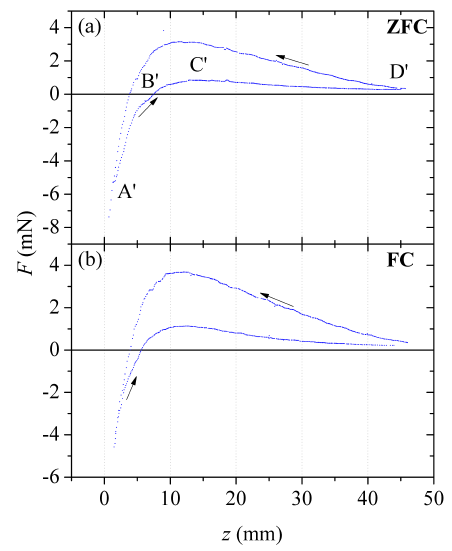
Figure 3 Force vs. distance between an YBCO sintered superconductor and a Permanent Magnet in the ZFC and FC regimens. A hysteretic behaviour was observed in both cases. The maximum positive values correspond to a maximum repulsive force. The arrows show the direction of the relative displacement HTS-PM
As displayed in Table 2, the j c values obtained from ∆F measurements (j cF ) are smaller than those (j cM ) obtained from magnetization measurements ∆M, using a Vibrating-Sample Magnetometer. The uniform field approximation used to determine the j c values could be one of the main reason of the observed differences. However, in both cases for the two types of superconducting samples analyzed, it is possible to observe a remarkable difference between sintered and texturized samples. It is worth highlighting that the method we used for determination of jc allows us to observe differences as those obtained from magnetization measurements for samples prepared by different routes.
Table 2 Comparison between j c values determined from force and magnetization measurements. J cF and J cM were obtained from ∆F and ∆M measurements, respectively

Figure 4 shows the X-ray diffraction pattern for the sintered sample, which presents the characteristic peaks and intensity relations of the YBCO-123 superconducting phase, with lattice parameters a = (3.824829 ± 0.000863) Å, b = (3.883515 ± 0.001103) Å and c = (11.688500 ± 0.002617), as determined by Rietveld refinement. Small peaks from other non-superconducting phases in the material are also shown [41, 42].
Figure 5 shows the X-ray diffraction pattern for the texturized sample (MTG), which presents the characteristic peaks and intensity relations corresponding to the YBCO-123 superconducting phase, with lattice parameters a = (3.820621 ± 0.000251) Å, b = (3.886608 ± 0.000301) Å and c = (11.685328 ± 0.000408) Å, determined by Rietveld refinement. It is noticeable a preferential growth of the sample along the c -axis, corresponding to the (001) planes [43, 44].
The Oxygen contents in both samples were obtained from the lattice parameters [45-47]. The obtained values are δ > 0.15 and δ ≤ 0.10 for the sintered and texturized samples, respectively, which agrees with the superconducting behaviour observed in these samples.
Figure 6 a and b show both the magnetic field of the permanent magnet and the corresponding field gradient respectively, which were used to determine the magnetization of the samples (Equation (1)], and the j cF values (Equationes (2) and (3)].
5. Conclusions
The measurements of the interaction force HTS-PM were carried out with a relatively simple technique developed here, which is reproducible, reliable and low cost. This technique allows determining qualitatively some properties of the superconducting material for different applications. The experimental results were analyzed by using the Bean’s critical-state model for the case of a uniform field applied to the superconductor.
The hysteresis phenomenon of the force as a function of distance, because of the hysteresis in magnetization, was observed for both analyzed samples in the ZFC and FC regimes.
For the texturized (MTG) sample with efficient pinning centers, it is possible to observe both levitation and suspension phenomena. Levitation is a consequence of the magnetic flux exclusion (M < 0) and suspension a consequence of the trapped flux inside the material (M > 0). The interaction force was smaller by two orders of magnitude for the sintered sample with an Oxygen content of approximately 0.55 (δ > 0.15), than the texturized sample with δ < 0.10. On the other side, F(z) measurements have allowed determining the value of the critical current density (j c ), which, provided a simply method to establish, as in this case, characteristics and differences between superconductors prepared using different routes.
The critical current values determined using this technique showed remarkable differences between both analyzed samples, being higher in MTG sample than in the sintered one. A similar behaviour of j c was obtained by using other methods like magnetization measurements.
It is well-known that the ability to carry current (j c ) by a superconductor is strongly influenced by the method of preparation. The observations made with the developed system clearly show these differences, which, together with the reproducibility and reliable characteristics mentioned above, allow us to use this system for the qualitative determination of some superconducting properties. On the other side, the experimental results found out, fit with different analytical and numerical solutions which, have been studied using the critical state model and experimental results obtained by other authors [21, 48].

















